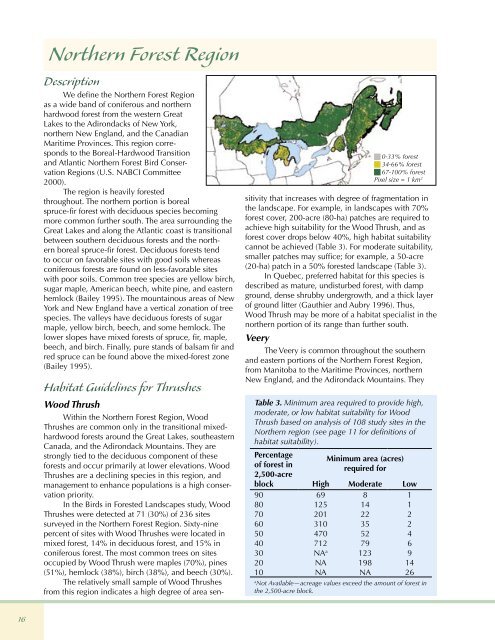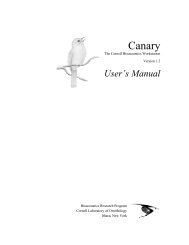A Land Manager's Guide to Improving Habitat for Forest Thrushes
A Land Manager's Guide to Improving Habitat for Forest Thrushes
A Land Manager's Guide to Improving Habitat for Forest Thrushes
Create successful ePaper yourself
Turn your PDF publications into a flip-book with our unique Google optimized e-Paper software.
16<br />
Northern <strong>Forest</strong> Region<br />
Description<br />
We define the Northern <strong>Forest</strong> Region<br />
as a wide band of coniferous and northern<br />
hardwood <strong>for</strong>est from the western Great<br />
Lakes <strong>to</strong> the Adirondacks of New York,<br />
northern New England, and the Canadian<br />
Maritime Provinces. This region corresponds<br />
<strong>to</strong> the Boreal-Hardwood Transition<br />
and Atlantic Northern <strong>Forest</strong> Bird Conservation<br />
Regions (U.S. NABCI Committee<br />
2000).<br />
The region is heavily <strong>for</strong>ested<br />
throughout. The northern portion is boreal<br />
spruce-fir <strong>for</strong>est with deciduous species becoming<br />
more common further south. The area surrounding the<br />
Great Lakes and along the Atlantic coast is transitional<br />
between southern deciduous <strong>for</strong>ests and the northern<br />
boreal spruce-fir <strong>for</strong>est. Deciduous <strong>for</strong>ests tend<br />
<strong>to</strong> occur on favorable sites with good soils whereas<br />
coniferous <strong>for</strong>ests are found on less-favorable sites<br />
with poor soils. Common tree species are yellow birch,<br />
sugar maple, American beech, white pine, and eastern<br />
hemlock (Bailey 1995). The mountainous areas of New<br />
York and New England have a vertical zonation of tree<br />
species. The valleys have deciduous <strong>for</strong>ests of sugar<br />
maple, yellow birch, beech, and some hemlock. The<br />
lower slopes have mixed <strong>for</strong>ests of spruce, fir, maple,<br />
beech, and birch. Finally, pure stands of balsam fir and<br />
red spruce can be found above the mixed-<strong>for</strong>est zone<br />
(Bailey 1995).<br />
<strong>Habitat</strong> <strong>Guide</strong>lines <strong>for</strong> <strong>Thrushes</strong><br />
Wood Thrush<br />
Within the Northern <strong>Forest</strong> Region, Wood<br />
<strong>Thrushes</strong> are common only in the transitional mixedhardwood<br />
<strong>for</strong>ests around the Great Lakes, southeastern<br />
Canada, and the Adirondack Mountains. They are<br />
strongly tied <strong>to</strong> the deciduous component of these<br />
<strong>for</strong>ests and occur primarily at lower elevations. Wood<br />
<strong>Thrushes</strong> are a declining species in this region, and<br />
management <strong>to</strong> enhance populations is a high conservation<br />
priority.<br />
In the Birds in <strong>Forest</strong>ed <strong>Land</strong>scapes study, Wood<br />
<strong>Thrushes</strong> were detected at 71 (30%) of 236 sites<br />
surveyed in the Northern <strong>Forest</strong> Region. Sixty-nine<br />
percent of sites with Wood <strong>Thrushes</strong> were located in<br />
mixed <strong>for</strong>est, 14% in deciduous <strong>for</strong>est, and 15% in<br />
coniferous <strong>for</strong>est. The most common trees on sites<br />
occupied by Wood Thrush were maples (70%), pines<br />
(51%), hemlock (38%), birch (38%), and beech (30%).<br />
The relatively small sample of Wood <strong>Thrushes</strong><br />
from this region indicates a high degree of area sen-<br />
sitivity that increases with degree of fragmentation in<br />
the landscape. For example, in landscapes with 70%<br />
<strong>for</strong>est cover, 200-acre (80-ha) patches are required <strong>to</strong><br />
achieve high suitability <strong>for</strong> the Wood Thrush, and as<br />
<strong>for</strong>est cover drops below 40%, high habitat suitability<br />
cannot be achieved (Table 3). For moderate suitability,<br />
smaller patches may suffice; <strong>for</strong> example, a 50-acre<br />
(20-ha) patch in a 50% <strong>for</strong>ested landscape (Table 3).<br />
In Quebec, preferred habitat <strong>for</strong> this species is<br />
described as mature, undisturbed <strong>for</strong>est, with damp<br />
ground, dense shrubby undergrowth, and a thick layer<br />
of ground litter (Gauthier and Aubry 1996). Thus,<br />
Wood Thrush may be more of a habitat specialist in the<br />
northern portion of its range than further south.<br />
Veery<br />
The Veery is common throughout the southern<br />
and eastern portions of the Northern <strong>Forest</strong> Region,<br />
from Mani<strong>to</strong>ba <strong>to</strong> the Maritime Provinces, northern<br />
New England, and the Adirondack Mountains. They<br />
Table 3. Minimum area required <strong>to</strong> provide high,<br />
moderate, or low habitat suitability <strong>for</strong> Wood<br />
Thrush based on analysis of 108 study sites in the<br />
Northern region (see page 11 <strong>for</strong> definitions of<br />
habitat suitability).<br />
Percentage<br />
of <strong>for</strong>est in<br />
2,500-acre<br />
block<br />
Minimum area (acres)<br />
required <strong>for</strong><br />
High Moderate Low<br />
90 69 8 1<br />
80 125 14 1<br />
70 201 22 2<br />
60 310 35 2<br />
50 470 52 4<br />
40 712 79 6<br />
30 NA a 123 9<br />
20 NA 198 14<br />
10 NA NA 26<br />
a Not Available—acreage values exceed the amount of <strong>for</strong>est in<br />
the 2,500-acre block.<br />
0-33% <strong>for</strong>est<br />
34-66% <strong>for</strong>est<br />
67-100% <strong>for</strong>est<br />
Pixel size = 1 km 2

















